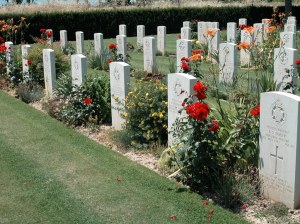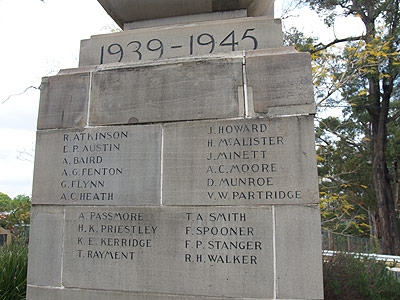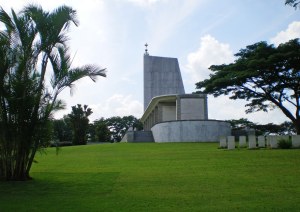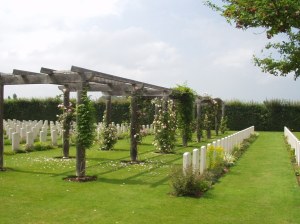Kew Gardens war memorial (from the Kew Gardens website) see also the WW1 Kew Gardens blog post on this memorial. .
Kew Gardens lost 14 serving and former staff in World War Two, commemorated alongside the Great War losses at the Kew Gardens war memorial in the Temple of Arethusa. A wreath is laid there each November on behalf of past and present Kew staff, a copy of one laid at the Cenotaph made by Kew staff for the Foreign Office on behalf of British Overseas Territories.
Kew Gardens staff and Old Kewites served all over the world in both World Wars and sadly this is where some of them lie buried, as far afield as the hills of Italy, the deserts of Libya, the jungles of Singapore and the battlefields of Normandy. Kew Gardens staff or Kew trained gardeners in both world wars also helped with the design and planting of war cemeteries, which are beautifully and respectfully maintained by the Commonwealth War Graves Commission gardeners.

One of RBG Kew Gardens’ WW2 staff casualties rests in this beautifully planted war cemetery, Assisi, Italy. (Image copyright CWGC website http://www.cwgc.org)
Looking through the 1940s issues of the Kew Guild Journal recently published online, there are short obituary tributes to the lives of these Kew Gardens and Old Kewite staff. I have added details from the Commonwealth War Graves Commission website. A recent discussion thread on the Rootschat forum listed brief details of the names of First World War casualties from Kew Gardens, which is covered in a separate blog post. There was however no list of easily accessible names for the 14 casualties from World War Two. A little detective work reveals the following complete list. I hope this is of use to family historians, as well as a tribute to these brave men.

1939-45 panels, Kew Gardens War Memorial, M to T name section.
Image: Mark Norris, World War Zoo Gardens Project
Photographs of Kew in both wars can be seen in the excellent book The Story of Kew Gardens in Photographs by Lynn Parker and Kiri Ross-Jones. There is an excellent selection on Kew in both wars in this book, including the employment of women gardeners to replace the men on active service, ‘Dig for Victory’ allotments and the ARP preparations for air raids.
G.H.Larsen 13 September 1944
Born November 25 1914 in France, Georges Henri Larsen came to Kew on exchange from the Luxemburg Gardens, Paris 1935-36. Serving with Corps Franc d’Afrique and Free French forces in Normandy, Larsen was killed in the fighting at Epinal.
C.G. Last, 22 June 1944 MM, Military Medal
Died aged 36, Corporal 9900V, Cecil George Last served with the South African Medical Corps, attached First City / Cape Town Highlanders, South African Forces, buried at Assisi War Cemetery, Italy. This is mostly burials from June – July 1944 from battles with the Germans who were trying to stop the Allied advance north of Rome. Born October 12, 1910 he was the son of William G and Beatrice Last of Letchworth, Hertfordshire.
His Kew Guild obituary notes that he was killed at Chiusi in Italy whilst attempting “under heavy shell fire … to bring to safety one of his native stretcher bearers who was wounded and exposed to heavy fire.” He was previously noted for gallantry and awarded the Military Medal whilst wounded in the Desert campaign. He served as a medic with the South African Highlanders until after El Alamein.

C.G.Lasts’s burial place lies amongst the graves of Assisi War cemetery, Italy (image CWGC copyright http://www.cwgc.org)
J.G. Mayne, 16 May 1944
Lieutenant, 48th Highlanders of Canada, Royal Canadian Infantry Corps.
Buried at the Cassino War Cemetery, Rome. Monte Cassino was finally taken two days after Mayne’s death.
Born on January 1st 1914, ‘Jack’ was the son of Robert Furlong Mayne and Kathleen Mayne. He attended Kew from 1938 to 1939 before leaving for an exchange post at the Ontario Agricultural College. He married Mary Mayne, Frimley, Surrey in England in 1943 and his only daughter was born after his death.

J.G. Mayne’s burial place, Cassino War Cemetery, Monte Cassino, Italy
(image copyright: CWGC http://www.cwcg.org)
W.S.H. Menzies, 2 July 1943
Sergeant William Sydney Hugh Menzies, Sergeant Wireless Operator, RAF (Volunteer Reserve) buried Sleaford Cemetery, Lincolnshire. Garden boy at Kew 1936-38. Son of William Duncan Graham Menzies
R. F. Miles, 11 May 1942
Reginald Frederick Miles 1375370, RAF (Volunteer Reserve), aged 26. He is one of 47 air force burials in Dunure Cemetery, Ayrshire. Born July 21st 1915, Miles was a student gardener at Kew from 1932-34 and returned to work in the Tropical department in 1938 until call up on September 23 1940. He crashed off the West Coast of Scotland during a training flight and was listed as missing for four months until identified and buried. “A wreath from the Kew Guild was among the floral tributes”, his Kew Guild Journal obituary noted. He was the son of Frederick William and Ethel Miles, Clench Common, Wiltshire.
J.C.Nauen, 10 September 1943
Assistant Curator, Botanic Gardens Singapore from 1935. Served with G.H. Spare as a Serjeant 5387, volunteer in the 3rd Battalion, (Penang and Province Wellesley Volunteer Corps) SSVF Straits Settlement Volunteer Force.
His botanic skills were of help gardening and collecting plants from the local area to help keep fellow prisoners alive. Nauen died as a Japanese POW prisoner of war, aged 40 working on the Burma-Siam railway in September / October 1943 of blood poisoning. He is buried in Thanbyuzayat CWGC Cemetery in Burma, alongside 1000s of fellow POW victims from the Burma-Siam railway. He was the son of John Jacob and Clara Nauen of Coventry.
Some of Nauen’s plant collecting herbarium specimens survive at Kew, whilst he has an interesting obituary in the Kew Guild Journal 1946 and The Garden’s Bulletin Singapore September 1947 (XI, part 4, p.266).
An interesting Kew Gardens archives blog post on the role of tropical botanists in keeping fellow POWs alive in internment camps has been recently written by James Wearn and Claire Frankland.
T.W. Rayment, 14 June 1942
Flight Sergeant Thomas Watkins Rayment, Air Gunner, 7 Squadron, RAF (Volunteer Reserve) aged 28. Buried at Avesnes-sur-Helpe Communal Cemetery, France.
‘Tommy’ Rayment is buried alongside several of his 7 Squadron crew (Pilot Officer Don White and Flight Engineer Sergeant Leonard Clinton Fenton) after being shot down during a bombing raid over Essen and the Ruhr, Germany’s industrial areas. Rayment’s was possibly the only Stirling bomber among several 7 Squadron bombers lost on this 1000 bomber raid. He was based at RAF Oakington near Cambridge and his crew’s death is recorded / confirmed in the ops notes on 25 August 1942 appendix of Oakington’s history .
The CWGC website lists him as the son of Herbert John Rayment JP and Louise Rayment, of Beecroft, NSW, Australia. Born to English parents working in the seed business in Australia, Tommy was at Kew from 1938-1940 in the Tropical & Decorative Departments. He volunteered for the RAF from July 23,1940 and survived many bombing missions. He was shot down once at sea, the sole survivor of his crew, picked up by a trawler after five hours in a rubber dinghy.
Rayment features on a war memorial at Beecroft , NSW, Australia. The memorial, Rayment’s life and a possible memorial to this Stirling crash are being researched by Beecroft historian Tony Cunneen and aviation researcher Joss Leclercq.

T W Rayment features on the Beecroft war memorial (Photo from the Register of War Memorials in Australia website) .
A probate record in the UK 10 March 1943 lists him as living at 1 Mortlake Road, Kew, Surrey before call up, his death / probate registered by Reuben Thomas Rayment (civil servant) and Dorothy Rayment (spinster) , presumably family members.
E.H. Robson, 23 October 1944
Born in 1912, Edward Herbert Robson entered Kew in 1935 after working in private estate gardens and became foreman in the Temperate House until 1938 when he moved to work in the parks of Coventry. He had already joined the Royal Berkshire Regiment in October 1940 by the time Coventry was bombed in late 1940 and 1941. His brother Major John Elliott Robson of the same regiment was also killed in Italy on 7th October 1944 and a third brother was injured and taken prisoner at Arnhem. His Kew Guild Journal 1946 obituary notes him as collecting and sending back plants and seeds throughout his service in Palestine, Egypt and Italy. His grave is in Florence War Cemetery in Italy.
F.G.Selby, 4 December 1943
Born August 4 1913, Frederick George Selby entered Kew from 1937 – 1942 serving as student gardener and then Foreman in the Decorative department after several years working in private gardens in Cornwall and Surrey. He joined the RAF on October 16, 1942 as aircrew becoming a Sergeant Air Gunner.
Selby was killed during a bombing raid on Leipzig on December 3-4, 1943. He is recorded as visiting Kew two days before his final flight. Air Gunner F.G. Selby is buried At Becklingen War Cemetery in Germany. He was the son of William Frank and Alice Selby, and husband of Rita May Selby.
Eric Egerton Smith, 23 November 1941
Trooper 7910903,11th Hussars, Royal Armoured Corps. Joined Born June 19 1914, Smith was at Kew as a student gardener from February 1939 to June 12 1940 when he enlisted in the 11th Hussars, after previous service with the Parks Department, Hounslow. Buried in Knightsbridge War Cemetery, Acroma, Libya. Smith died during the Libyan Desert campaign driving an armoured car on patrol towards Italian and German enemy lines at Sidi Rezegh. Son of George Egerton Smith & Lilian Nelly Smith, Heston, Middlesex.

Eric Smith’s desert burial ground Knightsbridge War Cemetery, Acroma, Libya (Image copyright: CWGC website http://www.cwgc.org)
G.H. Spare, 7 February 1945
Gordon Henry Spare, Private 6070 SSVF Straits Settlements Volunteer Force / 3rd Battalion (Penang and Province Wellesley Volunteer Corps), Singapore Volunteers, died at Labuan, Borneo as a Japanese POW. Remembered on column 396 Singapore Memorial. Son of Harry and Grace Spare, Wallington, Surrey, and husband of Rose Ellen Spare, Worthing, Sussex. His wife, young son and daughter were evacuated clear of danger before the Japanese invasion.

Singapore Memorial (image copyright CWGC website http://www.cwgc.org)
J.W. Sutch, 8 August 1944
Royal Armoured Corps, Trooper, 1st Northants Yeomanry. John Wilfred Sutch was born on November 8 1923 and served at Kew as a “Gardens boy” from 1939-1942. He is buried in the Banneville La Campagne war cemetery, Calvados, France. Sutch was a tank driver and died during the battle for the Falaise Gap in the Normandy campaign after D-Day.
A photograph of him in uniform can be seen in The Story of Kew Gardens in Photographs.

Beautifully kept garden setting of Banneville La Campagne War Cemetery , Calvados, France where Kew’s J.W.Sutch lies buried. (Image copyright: CWGC http://www.cwgc.org)
P.E.or R.E. Thyer, 17 June 1944
Lance Corporal 589614V, Royal Natal Carabineers, South African Forces, Bolsena War Cemetery, Italy. Born July 5 1911, Percy Ernest Thyer he was the son of William H. and Kate Thyer, Glastonbury, Somerset. (Listed on the cwgc.org.uk site as R.E. Thyer and in the Kew Guild Journal as P.E. Thyer). Thyer was at Kew between 1936 and 1937. He transferred to South Africa as an Exchange student at Government House Gardens, Pretoria in 1937 until he enlisted in 1943 after part-time service whilst still employed as a gardener. Thyer died aged 32, in action at Belvedere Farm, Citta d’Pieve, Italy. Many of the burials in this cemetery are related to a tank battle between the 6th South African Battalion and the Hermann Goering Panzer Division in Italy.
So that (as of April 2013) is brief information on 13 of the Kew casualties named on the bronze memorial plaque on the Kew Gardens memorial.
Allan Beard, 1946
The 14th and last name is Allan Beard, who served as a despatch rider with the Middlesex Regiment and died aged 31 a “tragic death” just after the war, possibly from injury related to war service. His obituary http://www.kewguild.org.uk/articles/1855/ appeared in the 1946 Kew Guild Journal.
Beard had been a gardener on the Parks Staff at Stamford Park, Ashton Under Lyne until he joined up in 1939. http://www.tameside.gov.uk/parks/stamford/history
Along with several garden colleagues, he had joined Hyde Company, Territorial Army section of the 6th Cheshire Regiment in early 1939; this would see him very quickly called into service three days before war broke out. By October 1939, he was serving with the Middlesex Regiment and fought through the campaigns of 1940 in Northern France and Belgium, eventually being evacuated from Dunkirk.
Back in Britain, instead of promotion Allan Beard chose to train as a despatch rider partly from a love of motorbikes. Sadly he was the victim of a wartime traffic accident (not surprising with blackout etc), being struck by an army lorry in Canterbury in 1943. By June 1944 he had been discharged from the army on medical grounds and returned to his previous garden job. Stamford Park by then had lost its railings in wartime, collected as salvage metal for the war effort, but had been maintained as a public park, popular like Kew Gardens with people encouraged in wartime to “holiday at home”.
Allan Beard entered Kew in August 1946 under a Government assisted training scheme. His obituary is reported in the 1946 Kew Guild Journal but not listed on the CWGC website as his death occurred as a civilian after military service. It may have been linked to his earlier accident.
Several other Kew related wartime casualties are mentioned in the Kew Guild Journal tributes but not listed on the Kew Gardens War Memorial.
Norman Laurence Harding, July 23 1941 RAF Sergeant Wireless Operator and Air Gunner, 18th Squadron, reported missing (later presumed killed in action) after an attack by Blenheim bombers on shipping off the coast of France on July 23 1941. Bought up at Kew, the son of Laurence Harding, Norman as a 19-year-old had worked in Kew’s Herbarium Library from 1933-34.
Percy Henry Patmore MBE, MM, 26 February 1944
‘Pat’ was a Ministry of Agriculture ARP Officer and a District Warden in Westminster during the war, well-known to many Kew staff. He earned his Military Medal in the First World War. He was killed by injuries from a bomb on his home at 80 Cat Hill in East Barnet in the little blitz of February 20 1944. Passed away from injuries in Wellhouse Hospital, 26 February 1944.
Posted on behalf of the World War Zoo Gardens Project at Newquay Zoo, researching what happened in zoos and botanic gardens in wartime. Find out more about the project on the Botanic Gardens Conservation International BGCI website article from the BGCI Roots journal by Mark Norris
Tags: 1940s, botanic gardens, Kew Gardens, Kew Guild, war memorials, WW2




December 26, 2013 at 10:24 pm |
Hi
This is a great find – Tommy Rayment lived nearby in Beecroft Australia and we are trying to find out more about him.
So thank you for this.
Any further infoormation would be gratefully received.
Regards
Tony
LikeLike
December 28, 2013 at 8:59 pm |
Dear Tony
I hope that you have seen the message and contacted Joss Leclercq the aviation historian who also left a comment. As well as a possible photo from Kew (Guild) Archives, the RAF Museum at Hendon should be able to help with RAF records. For WW2 service records these are not online and often only available to next of kin / family but I’m sure they would support your and Joss LeClercq’s efforts to find out more and create a memorial to such brave men. I don’t have worldwide Ancestry family history access so not currently able to help with Australian records but I’m sure someone closer to Beescroft will. His parents though being English will have left some records traces so I will find out what I can. Best wishes, Mark Norris, Newquay Zoo.
Magazines like Britain at War would also be interested in the memorial project.
LikeLike
September 2, 2014 at 7:44 pm |
Dear Joss and Tony,
I have added a photo of Tommy Rayment’s name section on the Kew Gardens memorial. Hope this is of interest to your research.
Mark Norris, World War Zoo Gardens project, Newquay Zoo
LikeLike
December 28, 2013 at 12:31 pm |
Hello from France
There’s a project for a memorial in St Rémy-du-Nord, in northern France, near the Belgian border, where the Stirling in which “Tommy” Rayment was the rear gunner crashed in June 1942.
As an aviation historian, I’m helping the project and I’d like to get any further informations about him, especially a portrait. We are actually making enquiries in Australia to trace his family.
Joss Leclercq
LikeLike
December 28, 2013 at 7:22 pm |
Kew Gardens often have staff portraits from intakes of student gardeners, so worth contacting their archive team. Thanks for your comments and best wishes for your project. Keep me posted. Mark Norris, World War Zoo Gardens project, Newquay Zoo
LikeLike
September 2, 2014 at 7:47 pm |
Dear Joss, Photo added of Tommy rayment’s name on teh Kew Gardens war memorial , hope this is of interest.
Mark Norris
LikeLike
February 23, 2014 at 9:26 am |
Norman Harding was my late mothers cousin
LikeLike
February 23, 2014 at 9:34 am |
Thanks for sending your comment, I’m glad it’s been of interest. It makes the research worthwhile. I put this information out on the web culled from the now online / scanned Kew Guild Journal, CWGC war graves website and other sources etc partly to help relatives tracing family historu but also as part of ongoing research in to wartime zoos and botanic gardens. The loss of staff was a major issue for many such organisations.
Kew Garden’s archives have photographs of many of their staff (certainly their student gardener intakes) and are planning commemorative events marking Kew in wartime, especially the Kew staff involved in WW1 for the 1914 centenary (see separate blog post)
Many Thanks
Mark Norris, World War Zoo Gardens Project
LikeLike
August 6, 2016 at 10:53 am |
[…] https://worldwarzoogardener1939.wordpress.com/2013/04/06/the-lost-gardeners-of-kew-in-world-war-two/ […]
LikeLike
December 11, 2019 at 9:47 am |
[…] https://worldwarzoogardener1939.wordpress.com/2013/04/06/the-lost-gardeners-of-kew-in-world-war-two/ […]
LikeLiked by 1 person